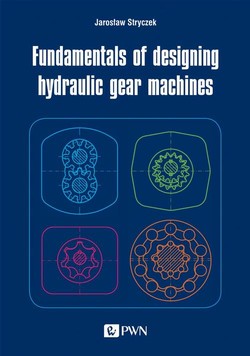Читать книгу Fundamentals of designing hydraulic gear machines - Jarosław Stryczek - Страница 9
На сайте Литреса книга снята с продажи.
2.1.2. General model of a motor
ОглавлениеFigure 2.2 presents the general model of a motor. The model includes a shaft (1), a gear system (2), and a housing (3). The drawing of the model does not show bearings and minor sealing elements, which, as it is assumed, are there. The gear system (2) features the intertooth displacement chambers T and in the housing (3) there is a system of channels CL and of internal clearances G. The transformation of hydraulic energy Ehydr accumulated in the stream of the working fluid into mechanical energy Emech is performed by the shaft (1) in the following way: the pump of the hydraulic system supplies the motor with the working medium through the inlet port I, and the medium flows into the intertooth displacement chambers T. Next, the chamber T moves with rotational motion (φ angle) in the system of channels CL and clearances G towards the outlet port O. On reaching the outlet port, the working fluid flows down into the tank. In a motor, there can be even several dozen displacement chambers T which, acting in sequence one after another, provide high torque on the shaft of the motor Mst.
Fig. 2.2. General model of the hydraulic motor of groups 1–3.1 – shaft, 2 – gear system, 3 – housing, CL – internal channels, G – clearances, T – intertooth displacement chamber, I – inlet, O – outlet
While the working fluid is flowing from the inlet zone I to the outlet zone O, its pressure falls from a high value pI down to a low value po. The expansion of the pressure results in the rotation of chamber T, the rotation of gears (2) and the generating of torque Mst on the drive shaft (1) of the motor.
The model is acceptable for all the four groups of the hydraulic gear machines presented in figure 1.2., working as motors. However, when considering machines of the fourth group working as motors, it is observed that the gears move with a planetary motion. It causes the intertooth displacement chamber T being filled in and discharged a number of times in order to generate one revolution of the drive shaft (1). A motor working in such a way is a multiple-action motor. The model presented in Figure 2.2 applies to a single-action motor, though. Nevertheless, that model can apply to a multiple-action motor, yet it refers to a single supplying-discharging cycle and a part of the shaft (1) revolution.
The problem is additionally analysed in Figure 2.3 where a separate model of the fourth group motor featuring multiple-action moveable axes is presented. The model, similarly to the fixed axes model shown in Figure 2.2, consists of a shaft (1), of a gear system (2) and of the housing (3). The gear system features displacement chambers T. The displacement chamber T shifts by φ angle corresponding to one working cycle. First, it connects with the supply pump through the inlet port I and the inlet channel CLI, and the supply with the working fluid at the high pressure pI is performed, as it Figure 2.3 depicts with a solid line. Next, the working fluid expands in the chamber T, which results in the revolution of the gear system (2) and the shaft (1).
Fig. 2.3. General model of the hydraulic motor of the fourth group.1 – shaft, 2 – gear system, 3 – housing, CL – internal channels, G – internal chambers, T – intertooth displacement chamber, I – inlet, O – outlet
Finally, the chamber T connects to the outlet port O through the channel CLO, and the working fluid flows down into the tank at the low pressure po, which is presented in Figure 2.3 with a dashed line.
The comparison of the fixed axes motor model presented in Figure 2.2 with the model of the moveable axes motor in Figure 2.3 proves similar processes taking place in both. The difference lies only in the fact that in the fixed axes motor, the energy transformation process occurs within a complete revolution of the shaft, whereas in the moveable axes motor, the same process occurs within a part of the revolution of the shaft, and then it is repeated a number of times. In order to make the repetition process happen, a more complex system of supply channels and chambers CLI, G and relief channels and chambers CLo, G are necessary.
